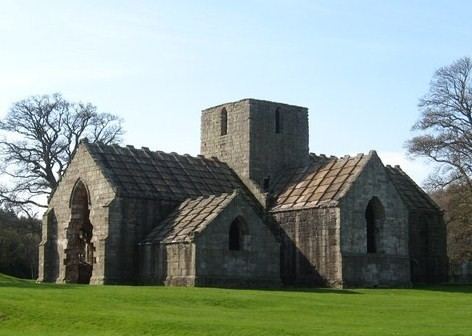Phone +44 1368 830868 | ||
 | ||
Similar Seton Collegiate Church, Hailes Castle, Greenknowe Tower, Chesters Hill Fort, Hopetoun Monument | ||
Dunglass Collegiate Church is situated in south-east East Lothian just off the old A1 highway, one mile north of Cockburnspath in Berwickshire, Scotland, UK.
Contents
History
The date of building the Chapel, dedicated to St. Mary of Dunglass, is unclear but when Sir Alexander Home of that Ilk was granted a charter, in 1421, to the lands of Dunglass the chapel was in existence. In 1423, Sir Alexander of Dunglass employed priests (a college) to pray for the family's souls and the chapel was raised to collegiate status which was confirmed by King James II of Scots in 1450 and confirmed by Pope Nicholas V. The college was composed of a provost, three chaplains and four boy choiristers. The church consisted of, originally, a nave and a choir and the Home or Hume burial vault. Later, in the 16th century transepts were added and a new tower. In 1544 the church was attacked by the Earl of Hertford's army during the wars of the Rough Wooing but the locals managed to repel the insurgents. In 1560, the church closed at the onset of the Scottish Reformation. An Act of the Scottish Parliament in 1563 abolished mass forever and the church's days as a Roman Catholic Chapel were over. In the early days of the church, a hospital, to offer solace and aid to the sick, was built nearby and dedicated to St. Mary and John the Baptist. The building is built of ashlar sandstone and roofed by stone slabs though the tower in now unroofed.
Later years
After the closure of the college church, it was still used as a parish church until the 18th century before it was sold to a farmer. The holy building was desecrated when the farmer bulldozed the east window to make way for his vehicles and the church including the burial aisle was used as a barn. In 1807 some dignity was restored when Sir John Hall bought Dunglass; the family later used the south transept as a burial aisle. In 1919 the estate was purchased by the Usher family.
The present day
Dunglass Church is now in the care of Historic Scotland and is situated in an idyllic situation surrounded by well manicured lawns and thick woodland. An interesting sundial stands on a mound adjacent to the ancient edifice. Dunglass Collegiate Church is one of the top attractions in East Lothian.
